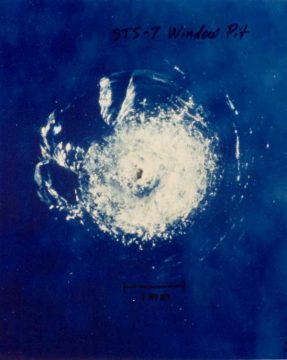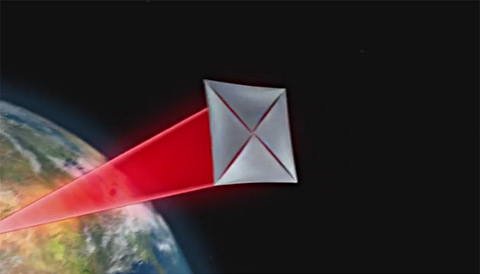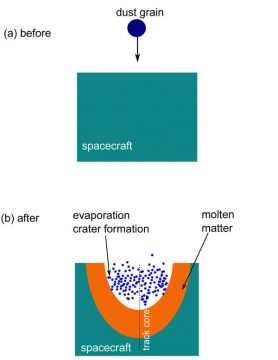Dust and gas between stars would pose a threat to spacecraft en route from Earth to Proxima Centauri — and scientists are seriously considering the problem now that the prospect of interstellar travel is no longer sci-fi.

NASA
Am I the only one who cringes every time Captain Kirk orders “Warp speed!” aboard the U.S.S. Enterprise? As the spaceship accelerates to the speed of light (and beyond, because, hey, it’s fiction), I can’t help but think: what if they run into something?
It wouldn’t take much. In 1983 a micrometeoroid collision cracked the window of the Space Shuttle Challenger, though the damage was non-critical. That was with the shuttle traveling at an orbital speed of only 18,000 mph, nine times the speed of an average rifle bullet — but only 0.0027% the speed of light.
If we ever want to travel at truly relativistic speeds to reach the nearest stars, spacecraft will have to endure far more — and the planet discovered around Proxima Centauri makes the prospect of interstellar travel awfully tempting.
The Breakthrough Starshot initiative intends to do just that. Last April, billionaire Yuri Milner announced he was putting $100 million on the table to fund scientists and engineers to test the feasibility of sending gram-scale spacecraft on a 20-year journey to the Alpha Centauri system at 20% the speed of light.
At one-fifth lightspeed, even micron-size dust grains gas atoms between stars pose a real threat, one that’s listed among the initiative’s challenges. But how much of a threat? That’s the question Thiem Hoang (University of Toronto) and colleagues set out to answer. (Full disclosure: two of the four coauthors help lead the Breakthrough Starshot initiative.)
Traveling through the Interstellar Medium

In a paper posted August 18th to the online preprint server arXiv.org Hoang’s team explored what might happen to a tiny, gram-scale probe like that proposed by Breakthrough Starshot: a mini spaceship made of a computer chip that contains the all-important sensors (composed primarily of silica) and a reflective lightsail vital to accelerating the craft (composed of graphite).
Because of the probe’s high speed, it essentially sees any lone atom or dust mote floating in space as a relativistic projectile. Dust is the main enemy. While interstellar gas is mostly hydrogen and helium, with a few other trace elements thrown into the mix, cosmic dust particles, while tiny and rare, are composed mostly of heavier atoms. At relativistic speeds, every dust grain that gets in the way will both evaporate and melt material on the spacecraft, generating an impact crater.
If the dust grain is any bigger than 15 microns (roughly the width of a human hair), the crater it makes will encompass a gram-scale spacecraft — in other words, a single “large” dust grain would destroy the whole probe! Fortunately, cosmic dust grains of this size are rare: the authors peg the chance of running into one of them at one in 1050 (that’s one in a trillion trillion trillion or so, or in other words, practically never). Still, impacts from smaller grains could be enough to damage sensors or other key components.
Though dust can wreak havoc, interstellar gas shouldn’t be ignored, the team found. The few heavy atoms in the diffuse gas between stars can do their share of damage. They’re particularly dangerous to silica-based materials (not so much to the graphite-based lightsail), leaving tracks of damaged in their wake that gradually weaken its strength.
Incorporating all of these effects, Hoang and colleagues calculated how deeply interstellar gas and dust could erode the surface of a thin, rectangular probe:
| Quartz | Graphite | |
|---|---|---|
| Interstellar gas | 0.1 mm | 0.01 mm |
| Interstellar dust (evaporation) | 0.5 mm | 0.5 mm |
| Interstellar dust (melting) | 3 mm | 1 mm |
The numbers are in line with lab experiments that have shot energetic particles at matter, though more data is still needed to test how high-speed dust molecules would interact a solid surface.
Shields Up, Mr. Sulu!

Hoang et al., arXiv.org
So, how does one protect a spacecraft traveling at a significant fraction of lightspeed? Hoang and colleagues suggest two complementary approaches. One is to make the spacecraft long and slim, like a needle: the less surface area the spacecraft presents to the onslaught of interstellar debris, the less damage it’ll take — especially from cosmic dust. (The concept is similar to the aerodynamic design of cars and airplanes, though for entirely different reasons.)
The second approach is to shield the probe with some kind of protective covering, such as a graphite coating a few millimeters deep. The lightsail itself — which is really only necessary for acceleration — could provide additional shielding, the authors suggest, if it’s folded up in front of the sensor-laden chip once the probe is underway.
So an interstellar flight to Proxima Centauri might well be feasible. And flying out of the solar system isn’t a problem because the Alpha Centauri system lies out of the ecliptic plane. The caveat, says coauthor Abraham Loeb (Harvard University), is that we know very little about how the level of dust rises near the star — we don’t even know how “edge-on” we’re seeing Proxima Centauri.
“There is a risk that if its dust content is much larger than that of the solar system, it will damage the spacecraft,” Loeb explains.
Loeb chairs Breakthrough Starshot’s advisory board, which just convened this week to organize the initiative’s first five to ten years. During this first phase, scientists and engineers will test the feasibility of travel to the nearest star system.
The recent discovery of an exoplanet around Proxima Centauri, Loeb adds, provides an obvious target for a flyby mission — and a sense of urgency for seeing results within our lifetimes.
 22
22









Comments
Robert-Casey
August 25, 2016 at 4:10 pm
I suppose the lightsail could also serve as the dish part of a dish antenna, to transmit data back to Earth (if they use radio and not lasers, or use both as backup). You could put the tiny probe at the focus of the dish, and the dish should help scatter the dust particles to a safer level.
What's the power source for the probe? A powerful laser beam from Earth? Will it slow down when it gets there at Proxima, so we get more time to look around?
You must be logged in to post a comment.
Frank-ReedNavigation.com
August 26, 2016 at 2:52 am
No, a micro-probe like this would not slow down. The idea is to launch hundreds, even thousands, of these tiny probes. We can make up for any quality with quantity.
You must be logged in to post a comment.
john jain
August 25, 2016 at 5:07 pm
Not only will it not be able to slow down, but space will be contracted and time will be slower. I wonder what that will do to the images. It will be the first time someone tried to photograph a slowly moving object from a high speed camera. How to focus it is going to be interesting. The image will likely be blurred because of the high speed of the camera. How to "unblurr" it introduces an interesting question. How? What if we could make a tiny ion propulsion engine? Then we could accelerate half of the trip and decelerate the other half and arrive with a velocity low enough to allow us to put some of these little spacecraft in orbit around Proxima b, Proxima Centauri, and Alpha Centaury one tenth of a light year away. This pair will be interesting a bit because they are a binary pair and not unlike our own sun. Fun fun fun. If the adults find out how much fun we're having they will surely make us stop.
You must be logged in to post a comment.
Frank-ReedNavigation.com
August 26, 2016 at 11:38 pm
You suggested that space would be contracted and time dilated, but at 20% of the speed of light these relativistic effects amount to only about 2%, nothing worth noticing. You're quite correct though that photography is difficult from such a fast platform, but really ANY photography at all will require some brilliant engineering on such tiny spacecraft. It would not be tough to get long range imagery, for example photographing planets from a distance of 50 million miles, but it's hard to justify an interstellar mission if that's as good as it gets when you consider that very large space telescopes right here in the Solar System should be able to achieve nearly the same and sooner. Creating a spacecraft with sensors that can actually do something unique and scientifically valuable at the destination --that's the real challenge.
You asked about making a "tiny" ion engine. Any onboard rocket propulsion is ultimately constrained by the rocket equation and even for very fast ions and extremely small payload, any design that slows down at the destination will be enormously massive on launch. The whole idea of these "Starwisp"-like designs (https://en.wikipedia.org/wiki/Starwisp) is the keep the momentum driver here in the Solar System. It's a laser that pushes the spacecraft, and this yields a huge savings in mass. Now... if we could find some friends at the other end who ALSO have a laser, well then we can slow down for a visit. 🙂
You must be logged in to post a comment.
Frank-ReedNavigation.com
August 27, 2016 at 5:14 pm
You noted that space would be contracted and time dilated, but at 20% of the speed of light those factors only amount to about 2% --relatively insignificant and nothing to worry about. You're right though that photography is a huge challenge.
You must be logged in to post a comment.
Mickey-Fratesi
August 26, 2016 at 7:09 pm
Evidently you do not know about IDEA(interstellar dust evasion apparatus)..probably because it was invented six centuries after you were born.
You must be logged in to post a comment.
Justin S
August 27, 2016 at 12:03 pm
Does anyone take this idea seriously? What kind of device would tolerate the indicated G forces? What kind of device weighing “a few grams” would be able to transmit anything over four light years?
You must be logged in to post a comment.
Fernando-Margueirat
August 27, 2016 at 3:53 pm
Lots of people believed that going to the moon was not a serious proposition. But with enough money and brain power it was accomplished. It seems that some money for this project has been made available, hopefully this will attract brain power.
You must be logged in to post a comment.
Frank-ReedNavigation.com
August 27, 2016 at 5:10 pm
Yes, quite a few people take it seriously. Stephen Hawking takes it seriously and signed up to be on the board of directors. I take it seriously... but that's just me. The general concept has been around for 30 years, and there's been quite a lot of back-of-the-envelope work on it. See "Starwisp": https://en.wikipedia.org/wiki/Starwisp
You must be logged in to post a comment.
Justin S
August 27, 2016 at 12:26 pm
At 20% of the speed of light, using Newtonian physics, each gram would have 1.8 trillion joules of energy. That’s about equal to 430 tons of TNT. Yes, I know that due to relativity it would be more than that.
You must be logged in to post a comment.
Frank-ReedNavigation.com
August 27, 2016 at 5:12 pm
There's little difference between kinetic energies calculated by Newtonian physics and by relativistic (Einsteinian) physics at 20% of the speed of light. This speed qualifies as "non-relativistic" by most any measure. It's certainly a lot of kinetic energy (relative to the Earth), but that only tells us it's expensive. It's not prohibitive in physical terms.
You must be logged in to post a comment.
Justin S
August 30, 2016 at 10:13 pm
Thanks. I was aware that 20% of the speed of light is not relativistic. But I expected to be slammed by people who thought it was.
You must be logged in to post a comment.
John-Martello
August 27, 2016 at 6:57 pm
In Star Trek, and by the way faster than light travel is completely possible which is explained in Star Trek and NASA confirmed it, the star ships were safe from debris as large as small asteroids by the navigational deflector (the dish in the front of the ship). This projected a deflector shield ahead of the ship that vaporized small particles and deflected larger objects. Larger asteroids, the size of the ship and larger, were detected by sensors and the ship would have to slow down and make a course correction... or destroy the object. I just wanted to point that out.
You must be logged in to post a comment.
Chris
August 28, 2016 at 12:37 am
What about the solar wind? Are there not about 2-6 protons/ cubic cm? (at least in the earth orbit distance)
Also, the stellar wind around the Centauri system.
You must be logged in to post a comment.
Peter Hannah
August 28, 2016 at 6:25 am
Monica, there's no need to cringe when the Captain says 'warp speed' - because in the Star Trek universe, warping from place to place involves jumping through hyperspace, traversing hardly any spatial distance at all, so no need to worry about hitting things. Also - perhaps forgetting this - the designers of the Enterprise thoughtfully placed that huge dish on the front of the ship - the Deflector dish - that is meant to generate a forcefield to deflect the path of any debris it encounters. Enough sci-fi, back to real science...
You must be logged in to post a comment.
Monica YoungPost Author
August 28, 2016 at 10:18 pm
Lol - I may even have known that, but then I've forgotten far more in my life than I currently know! That's funny that they have built-in redundancy though. Good to have the deflector shields just in case, you never know what lurks in hyperspace!
You must be logged in to post a comment.
Mark-Kelsey
August 28, 2016 at 8:16 am
Don't cringe any more. The Enterprise protected itself at warp speed by always projecting a force field in front to deflect objects in its path.
You must be logged in to post a comment.
Justin S
August 30, 2016 at 10:14 pm
Scientific history is littered with things that could not be done. I'm skeptical but I'll not assert this idea is impossible.
You must be logged in to post a comment.
Patrick-Thibault
August 31, 2016 at 10:06 pm
According to Halliday and Resnick's "Fundamentals of Physics" they list greater than 0.1c as relativistic. I'm just parroting, so you guys would know better than me. Just threw it in for clarification.
You must be logged in to post a comment.
Gregory-Parsons
September 4, 2016 at 10:08 pm
If they use a sail you won't get a large G force and you can use the photons that come at you to slow down. God to see that people are starting to think of light sails.
You must be logged in to post a comment.
HughP
November 2, 2016 at 2:03 am
Instead of a giant first step to Proxima, how about a proof-of-concept mission to Planet 9? We already have a rough idea of it's distance, direction, and velocity. By the time the first project is within a year of launch, we will have more precise information and, probably, some blurry images. We could get close-up data much faster than by going light years.
The people and groups behind the venture could share thousands of opportunities to suggest names. I suggest names be based on civilizations that had ended by 1,000 years before the Common Era. That is to say about 3,000 years ago.
You must be logged in to post a comment.
Clive Hodgson
February 5, 2017 at 2:42 am
Could graphene be useful as a material for the light sail? It's claimed to be 200 time stronger than steel and cheaper ways of manufacturing it are being found - see:
http://www.abc.net.au/am/content/2016/s4611679.htm
You must be logged in to post a comment.
You must be logged in to post a comment.